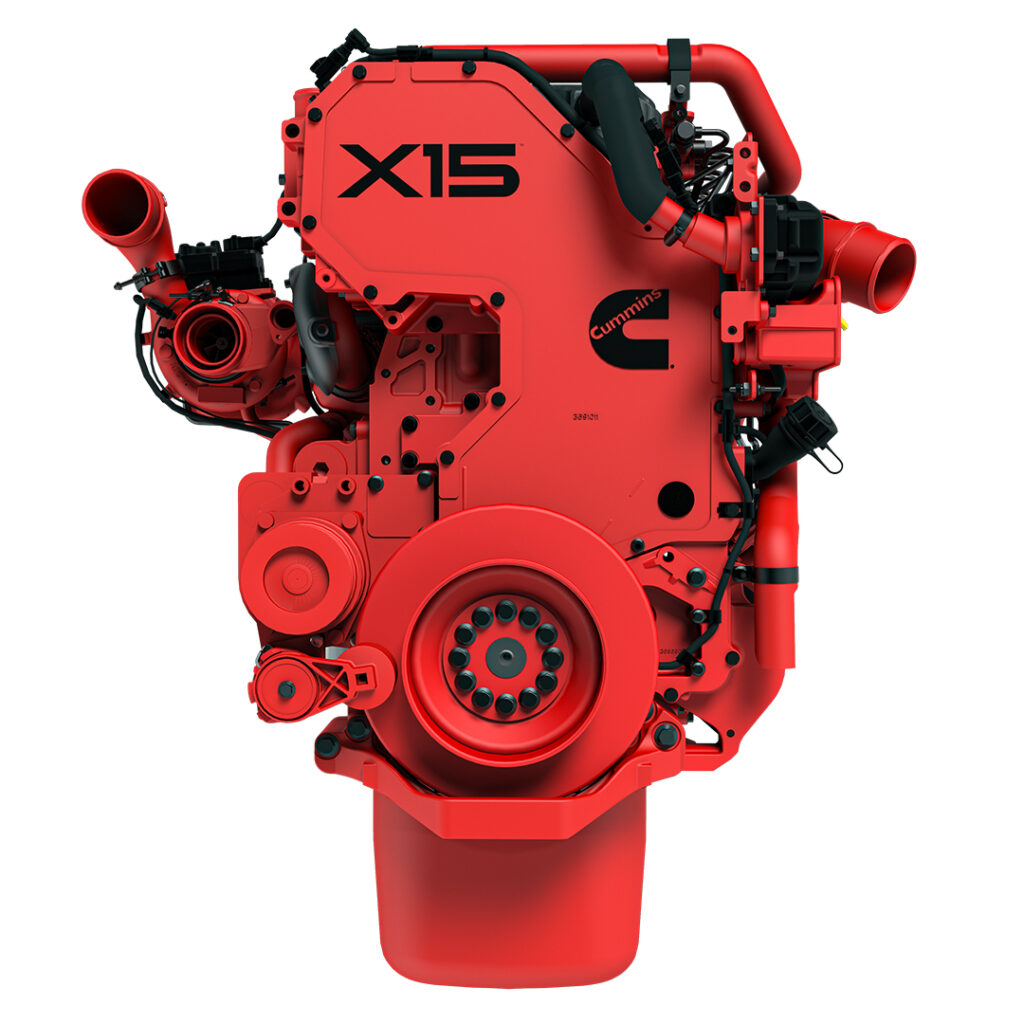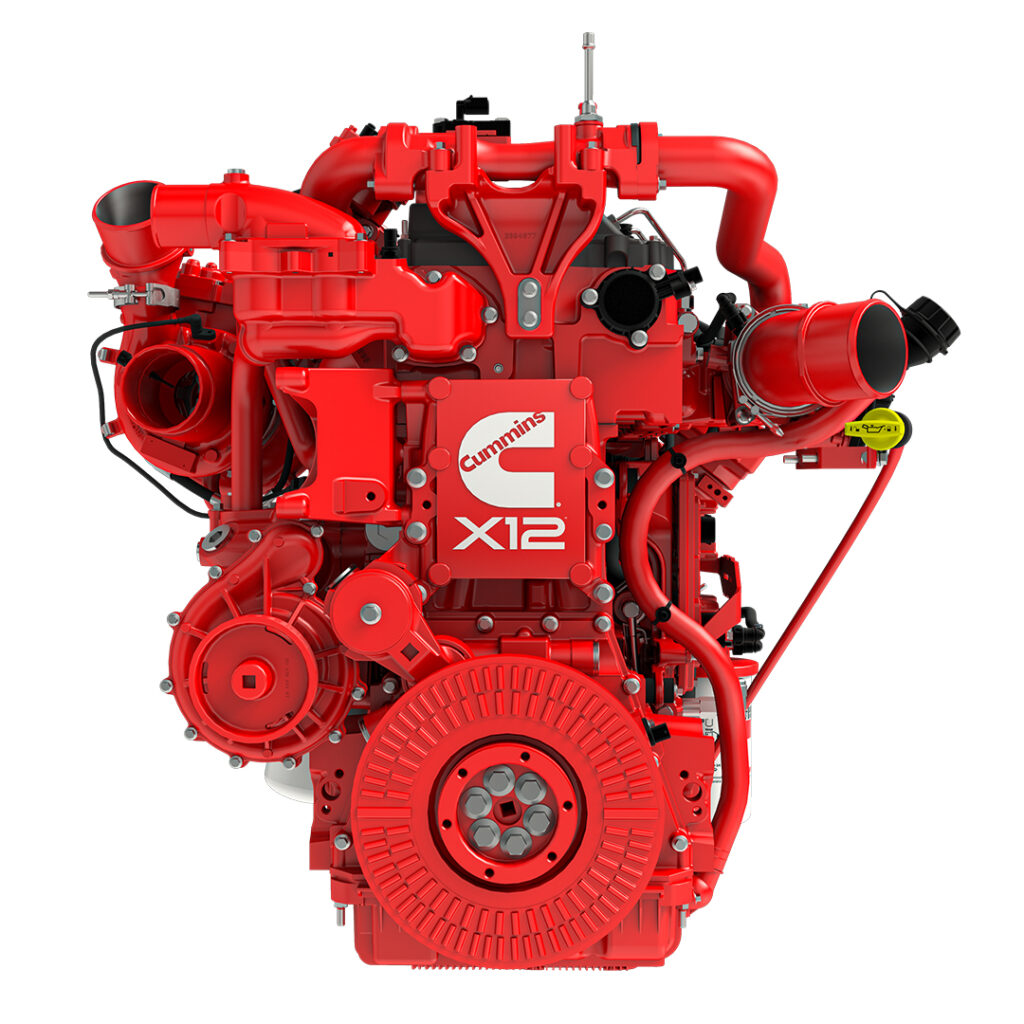Cummins unveils 2021 engine lineup
COLUMBUS, Ind. – Cummins has unveiled its 2021 X12 and X15 engine lineup, expanding the use of several features that have been limited to X15 Efficiency Series engines.
Fuel economy and oil drain intervals are experiencing a boost as well.

“Both the X15 and X12 share a market-leading 75,000-mile (120,000-km) interval for trucks getting seven or more miles per gallon (33.6 L/100 km),” said John Malina, executive director – sales for Cummins North American engine business, during a press briefing.
“Many customers of the X15 Performance Series will also see extended intervals in 2021. We’ve increased the oil change interval by 10,000 miles (16,000 km) for customers getting six to seven miles per gallon (39.2-33.6 L/100 km), as well as those getting five to six miles per gallon (47-39.2 L/100 km).”
The longer drain intervals largely come courtesy of the data collected through earlier oil analyses efforts, and the confidence the data brings.
The Cummins Oil Guard oil analysis program can even see trucks reach up to 100,000 miles (160,000 km) before needing an oil change, when using approved lubricants.
Added fuel economy
Specific fuel economy is admittedly tough to target, given the varied applications for these engines. But the X15 Efficiency Series enjoys 3.5% better fuel economy compared to its 2019 predecessor, said Nick Roth, director – national accounts.
Engine buyers who need more than 500 hp will see a 2% fuel economy boost in the X15 Performance Series, while base hardware changes in the X12 will see fuel economy increase 2.5% there. Compared to the ISX12, the latest X12 will see 8.5% better fuel economy, Roth said.
“For customer with older equipment, most product improvements within the same system architecture can be retrofitted for the best-possible trade-in value.”

Added engine performance
New EX ratings available for the X12 engines in linehaul and regional applications will include features that had been limited on the X15 – including on-ramp boost (a Cummins exclusive), predictive engine braking, predictive gear shifting, and dynamic power, said RaNae Isaak, powertrain and total cost of ownership consultancy leader.
Locating ramps using GPS signals, on-ramp boost trades off fuel economy in the name of maximum torque and a performance-focused shift schedule before hitting the highway itself.
Predictive engine braking can engage engine brakes to maintain speed, and predictive gear shifting matches the gear for the terrain ahead. Dynamic power, meanwhile, adjusts torque so lighter vehicles can operate like their heavier counterparts on grades, improving fuel savings for those who haul varying or diminishing loads.
“The previous adaptive features that required a unique engine calibration will be automatically enabled for the X12 EX ratings, so fleets will have access to additional efficiency-focused features like Smart Coast and Smart Torque 2 by default. Customers will still have access to these features in non-EX ratings. They simply can enable them after delivery,” Isaak said.
A new web-based tool known as Power Spec Web can be used to spec’ powertrains on the front end, adjust select features, and analyze driver performance through a reporting function. In the past, such reports required a PC-based software tool.
“A website with a URL location is a lot easier than someone downloading software,” she said.
More than skin deep
“When you look at the engines, you might notice some slight external modifications, but the bulk of what’s changed was internal components,” said Kris Ptasznik, heavy-duty on-highway product manager.
And changes to the X12 were still achieved while maintaining a 2,050 lb. weight.
“We’ve improved engine breathing, increased (the) compression ratio, and reduced friction losses through modified ring packs, to improve overall efficiency. We also offer an optional longer fuel filter that extends maintenance intervals to match market-leading oil drain intervals already available with the 2020 X12,” Ptasznik said.
The EX ratings for the X12 come to the engine courtesy of an updated ECM.
There’s also an option to reduce engine noise at idle with the help of an air compressor resonator, which has traditionally been limited to the X15.
Some of the updates to the X15 Performance Series were targeted for overseas customers, but buyers in North America will benefit as well. A larger thrust bearing, for example, means added durability for everyone, even though it’s largely needed to address particularly challenging road conditions in other regions.
“There’s no sense carrying two different base hardwares just to make that happen,” Ptasznik said.
Engineers are leveraging the engine’s EGR flow to help with engine braking, and like the X12 this powerplant will come with the new ECM and Cummins Acumen connectivity module that offers software updates, diagnostics, and Connected Advisor tools.
“We improved the air handling system for better compression ignition and engine efficiency. At the same time, we focused on reducing parasitics and frictional losses by improving the power cylinder, reducing the water pump speed, and resizing some critical components,” Ptasznik said.
Engine noise is also reduced at idle, while engine shutdown is enhanced as well, Cummins says.
Select powertrain features like Smart Coast, predictive cruise control, and a predictive road speed governor also come to X15 engines above 500 hp.
Power to come
While many power-related discussions currently focus on the future of battery-electric and fuel cell technologies, the manufacturer still sees a clear path for diesel.
“The mass customer in heavy-duty North America will continue to need a differentiated diesel that operates in their duty cycles and applications,” said Brett Merritt, vice-president of Cummins’ on-highway engine business.
The company challenged industry norms around diesel engines a century ago, unveiled natural gas engines in the 1960s, and 10-15 years later offered hybrid options, he said.
But it’s not stopping there. Five years ago it unveiled battery-electric systems, and hydrogen fuel cells are coming in the next few years.
“We think fuel cell will be a real option, particularly in certain applications,” Merritt said, referring to transit buses and heavy-duty trucks among them. The heavy-duty trucks to come late next year will plant some of the early seeds for such systems, he said.
“Electric, for a linehaul application, is not very good. How do you charge it, how do you possibly have that many batteries?”
The diesel power offerings must continue to evolve as well, as engineers explore the needs of 2024 emissions targets.
The challenges there will go beyond the lower NOx levels, Merritt said, referring to issues like warranty considerations that need to be addressed.
“We’ll have a full suite a products,” he promised.
“We’re in the market. Stay tuned.”
Full production of the 2021 product lineup begins Jan. 1.
Have your say
This is a moderated forum. Comments will no longer be published unless they are accompanied by a first and last name and a verifiable email address. (Today's Trucking will not publish or share the email address.) Profane language and content deemed to be libelous, racist, or threatening in nature will not be published under any circumstances.
-
Sound like you work for PACCAR
Paccar is the most expensive on Parts, Is a good engine quiet, but expensive to maintnain, senzitive on temperature, Cummins I think is better, even if is noisy, .. Their after treatment system is verry good.. I think cummins is the best diessel engine in North America
I’ve purchased 6 trucks over the past 10 years with Cummins power. The older ISX15 was much quieter then the X15, although the later is more efficient. Under load, the X15 sounds awful at 1400 rpm at our cruising speed of 100kms/h. The noise from the last 2 trucks with X15 /450hp were so annoying that I switched to the Paccar MX13 with 510hp rating. WHAT A DIFFERENCE!!! It’s super quiet and is more fuel efficient than the X15. I get that it’s a smaller displacement engine but the comparison between the two engines are pretty significant. I’ve kept track of fuel usage over the past two years and the paccar uses 450 litres less per month than the X15. This is comparing apples to apples, both units are doing the same loads/mileage per day. Just thought I would share this.
Regards,
Réal Tétrault